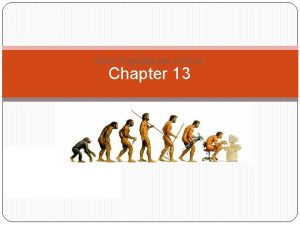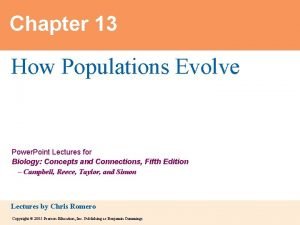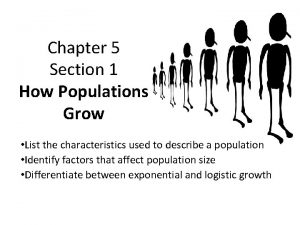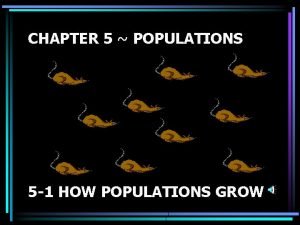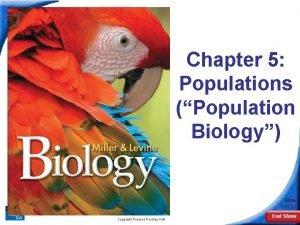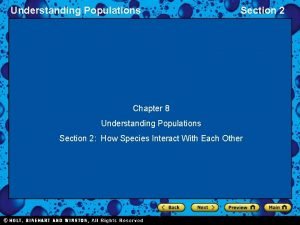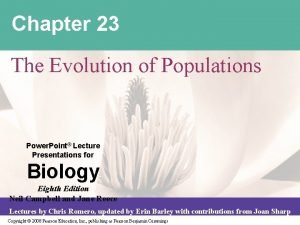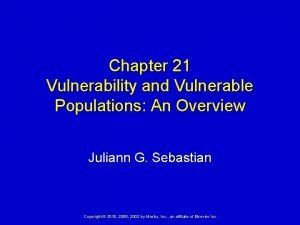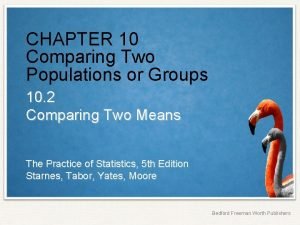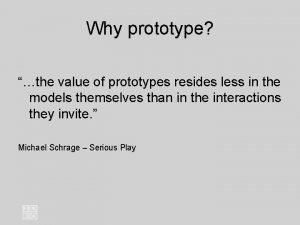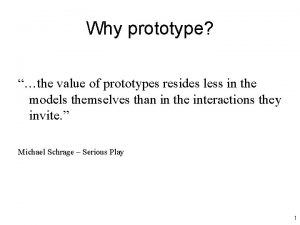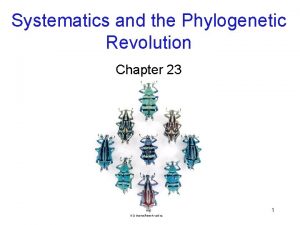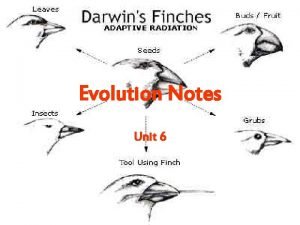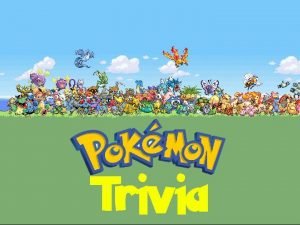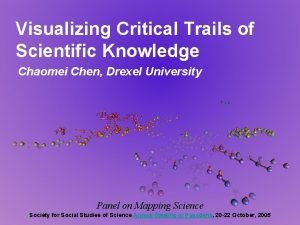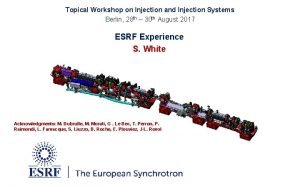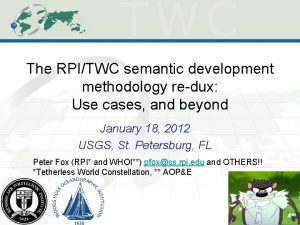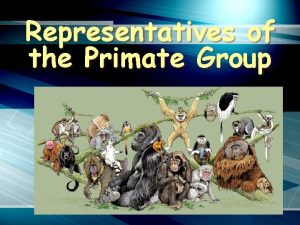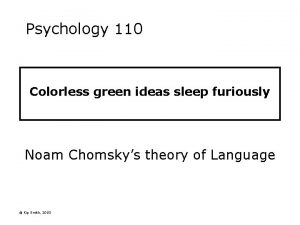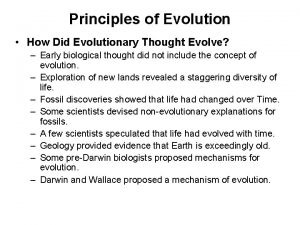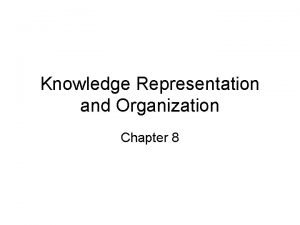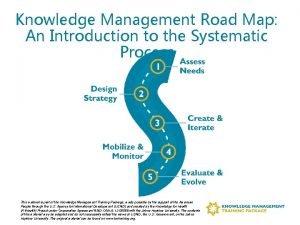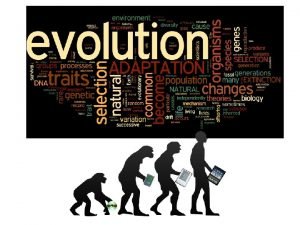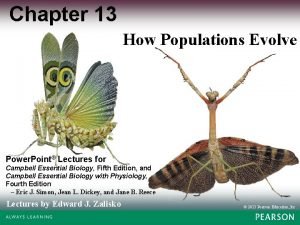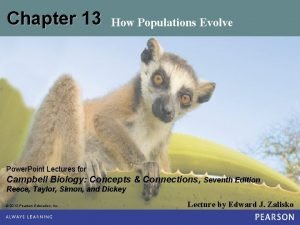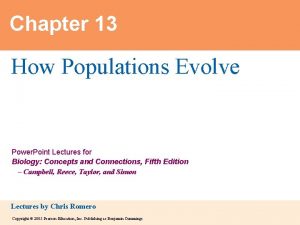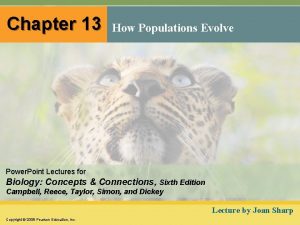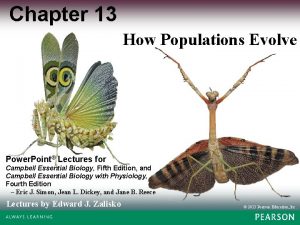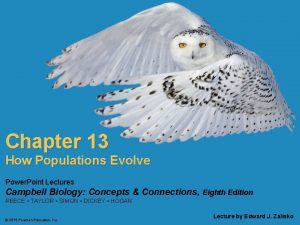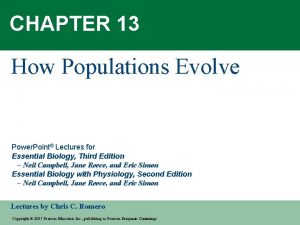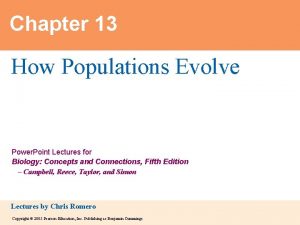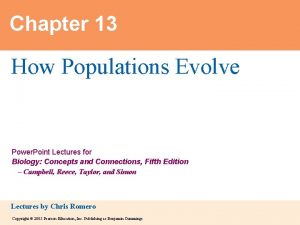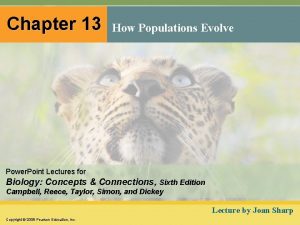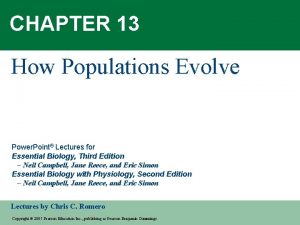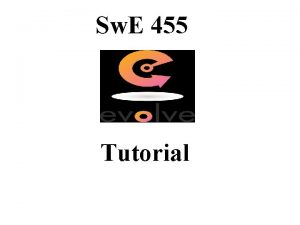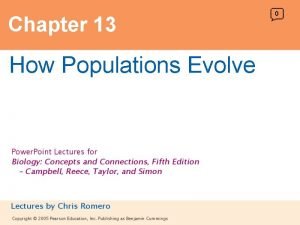CHAPTER 13 How Populations Evolve Power Point Lectures






































- Slides: 38

CHAPTER 13 How Populations Evolve Power. Point® Lectures for Essential Biology, Third Edition – Neil Campbell, Jane Reece, and Eric Simon Essential Biology with Physiology, Second Edition – Neil Campbell, Jane Reece, and Eric Simon Lectures by Chris C. Romero Copyright © 2007 Pearson Education Inc. , publishing as Pearson Benjamin Cummings





Figure 13. 1

Charles Darwin and The Origin of Species • Charles Darwin’s On the Origin of Species by Means of Natural Selection • Contemporary species arose from a succession of ancestors through a process of “descent with modification” • Natural Selection: How life evolves Copyright © 2007 Pearson Education Inc. , publishing as Pearson Benjamin Cummings

• The basic idea of natural selection is that a population of organisms can change over the generations if individuals having certain inheritable traits leave more offspring than other individuals. • Result: Evolutionary Adaptation- a populations increase in the frequency of traits that are suited to the environment Copyright © 2007 Pearson Education Inc. , publishing as Pearson Benjamin Cummings

• Evolution- Genetic composition of the population has changed over time • Great diversity of organisms, their: origins and relationships, similarities and differences, geographic distribution, and adaptation to surrounding environment. Copyright © 2007 Pearson Education Inc. , publishing as Pearson Benjamin Cummings

Evolutionary Adaptation Evolutionary adaptation is the result of natural selection; it is the increase in the frequency of traits that are well suited to the environment. Figure 13. 2

The Darwinian Revolution • Anaximander, a Greek philosopher, presented the first ideas on evolution • Aristotle contradicted him • Judeo-Christian ideas- all life was made exactly as it is • Darwin published his ideas in The Origin of Species after Alfred Wallace was going to publish similar ideas in 1859 • Published around the time of the Civil War in the Canyon U. S. -Grand very controversial Copyright © 2007 Pearson Education Inc. , publishing as Pearson Benjamin Cummings

Jean Baptiste Lamarck • Georges Buffon studies fossils to find that they seem to be ancient forms of current life • Lamarck suggested that the similarity between fossils and current life forms is due to evolution • Says evolution is a process of adaptation • Also proposed that certain characteristics are inherited • Set the stage for Darwin Copyright © 2007 Pearson Education Inc. , publishing as Pearson Benjamin Cummings

The Voyage of the Beagle • Darwin was 22 years old when he sailed on the Beagle, a survey ship, in 1831 • He was recommended for the voyage by John Henslow, a botany professor at Cambridge, the college Darwin attended • Mission was to chart the South American coast • Darwin collected many samples and specimens Copyright © 2007 Pearson Education Inc. , publishing as Pearson Benjamin Cummings

HMS Beagle Charles Darwin Figure 13. 4

The Voyage of the Beagle Continued • On his journey on the Beagle, Darwin – Collected thousands of specimens. – Observed various adaptations in organisms – Noted various adaptations – Observed plants and animals in different climates • In the Galapagos islands, Darwin observed many different adaptations in birds • Later led to the basis of his ideas Copyright © 2007 Pearson Education Inc. , publishing as Pearson Benjamin Cummings

• Darwin was intrigued by the tortoises and by the rocky island the lava that formed it. • Darwin was particularly intrigued by the geographic distribution of organisms on the Galapagos Islands Copyright © 2007 Pearson Education Inc. , publishing as Pearson Benjamin Cummings

A Marine Iguana, an example of the unique species inhabiting the Galapagos Figure 13. 5

Descent with Modification • Darwin made two main points in The Origin of Species: • First, he argued from evidence that the species of organisms inhabiting Earth today descended from ancestral species. • Second was Darwin’s argument for natural selection as the mechanism for descent with modification. Copyright © 2007 Pearson Education Inc. , publishing as Pearson Benjamin Cummings

Descent with modification Figure 13. 6

Evidence of Evolution • Evolution leaves observable signs • Like the Spaniards colonized Latin America (no written proof though there we deduce this from the Hispanic stamp on Latin American culture) • Biological evolution has left observable marks. Copyright © 2007 Pearson Education Inc. , publishing as Pearson Benjamin Cummings

The Fossil Record • Most fossils are found in sedimentary rocks • Over millions of years, deposits pile up and compress the older sediments blow into the rock. • Each rock layer bears a unique set of fossils representing a local sampling of the organisms that lived when that sediment was deposited • Younger strata are on top of older ones so the position of fossils in the strata reveal their relative age. Copyright © 2007 Pearson Education Inc. , publishing as Pearson Benjamin Cummings

Formation of sedimentary rock and deposition of fossils from different time periods Figure 13. 7

Strata sedimentary rock at the Grand Canyon Figure 13. 8

Comparative Anatomy • The comparison of body structures between different species. • Similarities among species can show signs of evolutionary history. • Limbs of different species could have different functions, yet be made of the same material. Copyright © 2007 Pearson Education Inc. , publishing as Pearson Benjamin Cummings

• Homology • Similarities due to common ancestry. • Not all likeness is inherited from a common ancestor. • The forelimbs of diverse mammals are not homologous structures. Copyright © 2007 Pearson Education Inc. , publishing as Pearson Benjamin Cummings

Figure 13. 11

Comparative Embryology • The comparison of anatomical structures that appear during the early stages of development of different organisms. • Similar stages in their embryonic development. • As development progresses, more distinctive features are noticeable. • One sign that vertebrates evolved is that all of them have an embryonic stage in which gill pouches appear on the sides of the throat. Copyright © 2007 Pearson Education Inc. , publishing as Pearson Benjamin Cummings

Figure 13. 12

Molecular Biology • The heredity background of an organism is documented in its DNA and it the proteins encoded by the DNA. • If two species have nucleotide sequences that are almost alike, scientists conclude that the two organisms are related to a common ancestor. • Molecular comparisons between diverse organisms allow scientists to create hypotheses about evolutionary divergence. Copyright © 2007 Pearson Education Inc. , publishing as Pearson Benjamin Cummings

• Natural selection/Darwins finches: Darwinian view: population on the different islands may diverge more and more in appearance as each population adapts to its local environment • Over many generations populations on different islands could become dissimilar enough to be designated as separate species. (example: of his observations of finches on the Galapagos Islands) finches strayed from the south American mainland then diversified on the different islands. (beaks) natural selection is the best explanation for the formations of the new adaption's. Figure 13. 13

Natural Selection • Darwin’s finches ( figure: a) the large ground finch: large beak specialized for cracking seeds that has fallen from plants to the ground. (b) small tree finch: smaller neck of the small tree finch used to grasp insects (C) woodpecker finch: long narrow beak allows ir=t to hold tools: cactus spines to probe for termites and wood boring insects. Copyright © 2007 Pearson Education Inc. , publishing as Pearson Benjamin Cummings Figure 13. 14

• Example of natural sel. : the evolution of pesticide resistance in hundreds of insect species (to control pesticides that transmit diseases, eat cropswidespread of it can lead to unintended development of pesticide resistant insect popu. ) • EXAMPLE 2: development of antibiotic-resistant bacteria (doctors documented an increase in drug resistant strains of HIV) Copyright © 2007 Pearson Education Inc. , publishing as Pearson Benjamin Cummings

Natural Selection in Action • Examples of natural selection include • genetic variation in popu. • different looks and temperament different genome different (variation can only be detected by biochemical mean: blood type) • phenotype results from a combination of the genotype which is inherited. • only the genetic component of variation is relevant to natural selection Copyright © 2007 Pearson Education Inc. , publishing as Pearson Benjamin Cummings

• variable traits in a popu. result from the combined effect of several genes • when a popu. includes 2 or more forms of a phenotypic characteristic, the contrasting forms are called morphs. • a population is a polymorphic for a characteristic if 2 or more morphs are present in noticeable numbers Copyright © 2007 Pearson Education Inc. , publishing as Pearson Benjamin Cummings

Genetic Variation in Populations • mutations & sexual recombination provide/produce genetic variation (they are random; natural selection are not) • mutations create new alleles (alternate forms of genes • harmless if it doesn't affect the proteins function) Copyright © 2007 Pearson Education Inc. , publishing as Pearson Benjamin Cummings

• organisms with short life span (bacteria)evolve rapidly with mutations a the only source of genetic variation • animals/ plants depend on sex. recomb. for genetic variation that makes adaption possible • environment promotes the propagation of those genetic combinations that enhance survival and reproductive success. Copyright © 2007 Pearson Education Inc. , publishing as Pearson Benjamin Cummings

Sources of Genetic Variation • Mutations and sexual recombination produce genetic variation • An organism is a refined product of thousands of generations of past selection mutations • Mutations can create new alleles • Mutant allele may actually enhance reproductive success • Organisms with short generation spans can evolve rapidly through mutations as the only source of genetic variation Copyright © 2007 Pearson Education Inc. , publishing as Pearson Benjamin Cummings

• Mutation and sexual recombination are random • While Natural Selection is not • The environment selectively promotes the propagation of those genetic combinations that enhance survival and reproductive success Copyright © 2007 Pearson Education Inc. , publishing as Pearson Benjamin Cummings
 Chapter 13 how populations evolve test
Chapter 13 how populations evolve test Chapter 13 how populations evolve
Chapter 13 how populations evolve Gene pool
Gene pool Power system lectures
Power system lectures Ac power formula
Ac power formula Power bi power point
Power bi power point Point point power
Point point power Chapter 16 evolution of populations vocabulary review
Chapter 16 evolution of populations vocabulary review Chapter 17 evolution of populations answer key
Chapter 17 evolution of populations answer key Chapter 5 lesson 1 how populations grow answer key
Chapter 5 lesson 1 how populations grow answer key 5-1 how populations grow
5-1 how populations grow Chapter 23: the evolution of populations
Chapter 23: the evolution of populations Section 16-1 genes and variation
Section 16-1 genes and variation Chapter 10 comparing two populations or groups crossword
Chapter 10 comparing two populations or groups crossword Chapter 5 lesson 1 how populations grow
Chapter 5 lesson 1 how populations grow Chapter 8 understanding populations
Chapter 8 understanding populations Chapter 23 the evolution of populations
Chapter 23 the evolution of populations Chapter 21 vulnerability and vulnerable populations
Chapter 21 vulnerability and vulnerable populations Chapter 10 comparing two populations or groups
Chapter 10 comparing two populations or groups Explore evolve validate prototype
Explore evolve validate prototype City and guilds evolve
City and guilds evolve City & guilds evolve
City & guilds evolve Explore evolve validate prototype
Explore evolve validate prototype Educate empower evolve
Educate empower evolve Hiv siv
Hiv siv Evolve
Evolve Pokemon
Pokemon Evolve knowledge
Evolve knowledge Evolve berlinist
Evolve berlinist Evolve knowledge
Evolve knowledge Prehistoric lemur
Prehistoric lemur Colorless green ideas sleep furiously
Colorless green ideas sleep furiously Ellis van creveld syndrome
Ellis van creveld syndrome Organization of declarative knowledge
Organization of declarative knowledge Evolve knowledge
Evolve knowledge Evolve knowledge
Evolve knowledge Evolve
Evolve Analogous structures
Analogous structures Evolve windows xp
Evolve windows xp
